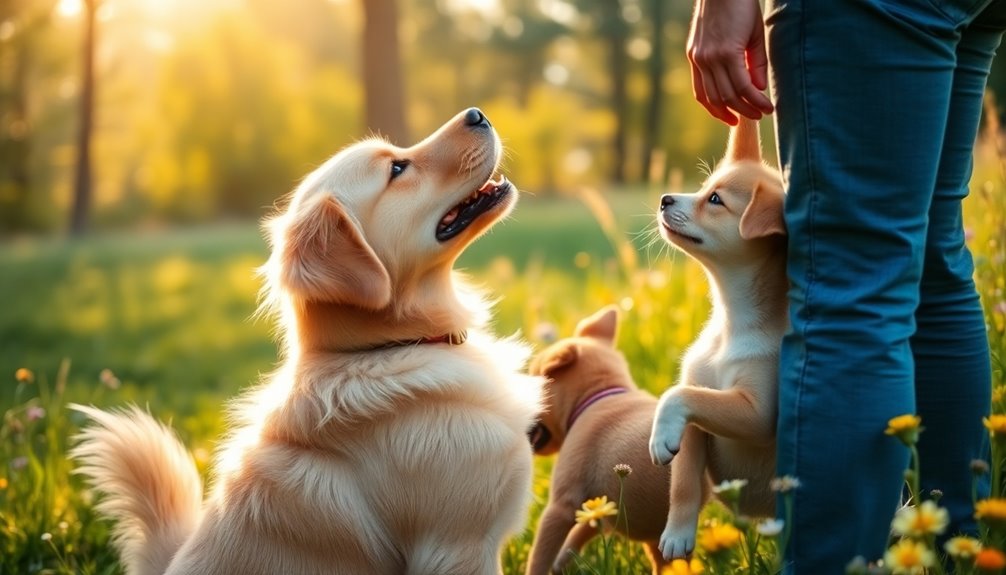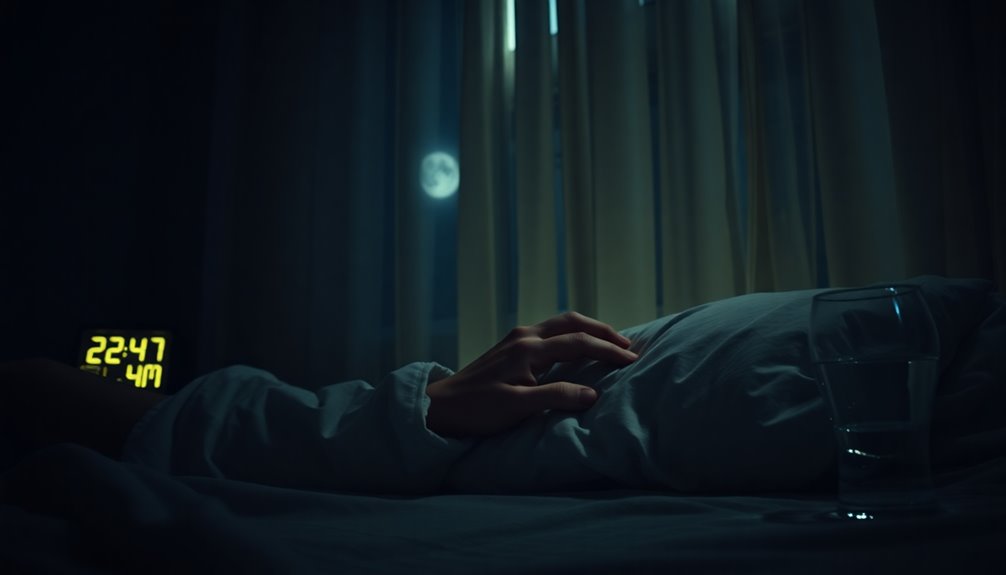Your dog absolutely knows you love him, and he shows it in various ways. Look for happy tail wags, relaxed bodies, and soft eye contact that indicate trust. If he curls up next to you or jumps to nuzzle against you, that's his way of bonding. Licking you is a sign of affection, while bringing you his favorite toy invites you to play. You might even notice him following you around or sleeping close for comfort. Each of these behaviors reflects his understanding of your love, and there's even more to uncover about how dogs express their feelings.
Key Takeaways
- Dogs express affection by leaning against you or exposing their belly, indicating trust and comfort in your presence.
- A soft gaze and gentle eye contact from your dog signify love and emotional connection.
- Physical contact, like cuddling or licking, reflects your dog's loyalty and desire for closeness.
- Engaging in play, such as bringing toys, shows your dog seeks interaction and values your companionship.
- Observing relaxed body language and wagging tails often indicates your dog feels happy and loved around you.
Tail and Body Language
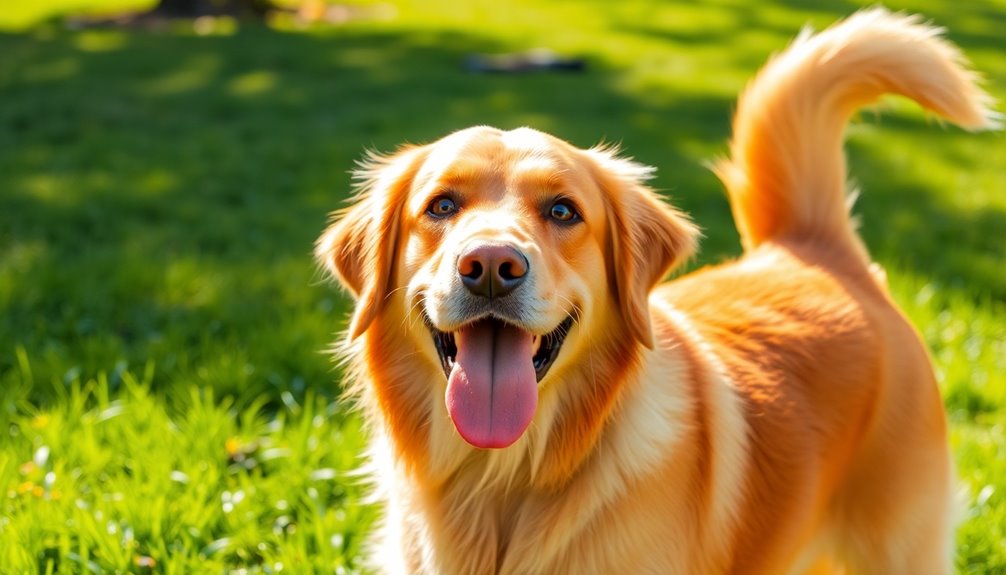
When you observe a dog's tail and body language, you can gain valuable insights into its feelings. A loose, wide wag usually indicates joy, while a broad wag shows excitement.
If you notice a gentle side-to-side wag, your dog likely feels relaxed. Pay attention to the speed and direction of the wag; a right wag often signals happiness, whereas a left wag can hint at anxiety. Additionally, dogs can be sensitive to environmental factors that may affect their behavior, such as noise or changes in their surroundings.
Combine this with body posture—like a relaxed mouth or a wiggly body—to gauge overall contentment. If your dog leans against you or exposes its belly, it's showing trust and affection. Understanding these signs helps you connect with your furry friend and appreciate its emotional state. Additionally, recognizing canine body language is crucial for preventing misunderstandings and ensuring safety.
Physical Contact and Proximity
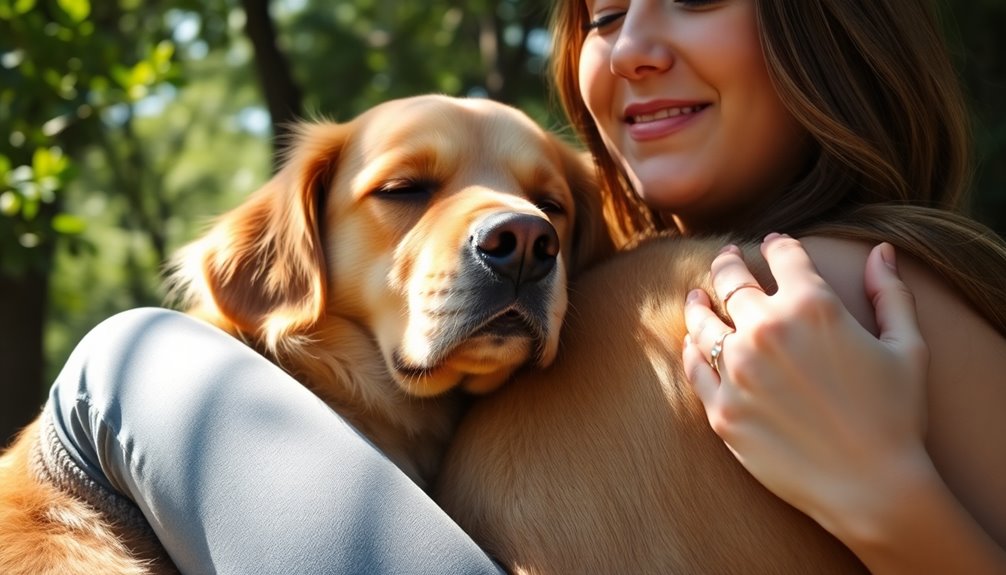
Dogs naturally seek physical contact and proximity with their owners as a way to express affection and build a strong bond.
You might notice your dog sitting near you, curling up on the couch, or even wedging themselves into your bed — all signs of comfort and attachment.
While some dogs enjoy cuddling, others prefer to snuggle close without being picked up. It's important to respect their personal space, allowing them to approach you for affection at their own pace.
Gentle strokes under the chin or scratches on the rump can be soothing and foster connection. Respecting dogs' personal space not only calms your dog but also releases oxytocin, strengthening the bond you share.
Eye Contact and Gazing
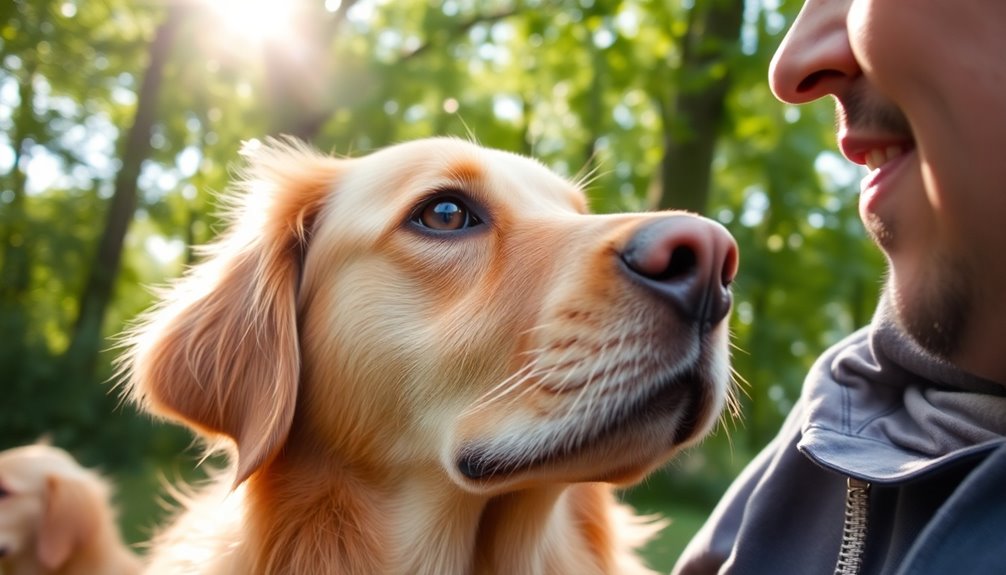
Eye contact between you and your dog can be a powerful indicator of affection and trust. When your dog looks at you with a soft gaze, it not only shows their love but also releases oxytocin, the feel-good hormone, in both of you.
This loving eye contact often comes alongside other signs of affection, like a wagging tail or a happy face. Your dog may use eye contact to communicate their needs or feelings, bridging the gap between species. In playful moments, a direct gaze can signal a desire to engage in games. Just remember, context matters; while gentle eye contact is a sign of happiness, prolonged stares may be misinterpreted and could signal stress or possessiveness. Additionally, prolonged eye contact can sometimes be perceived as a challenge, so it's important to be aware of your dog's comfort level during interactions.
Licking and Nuzzling
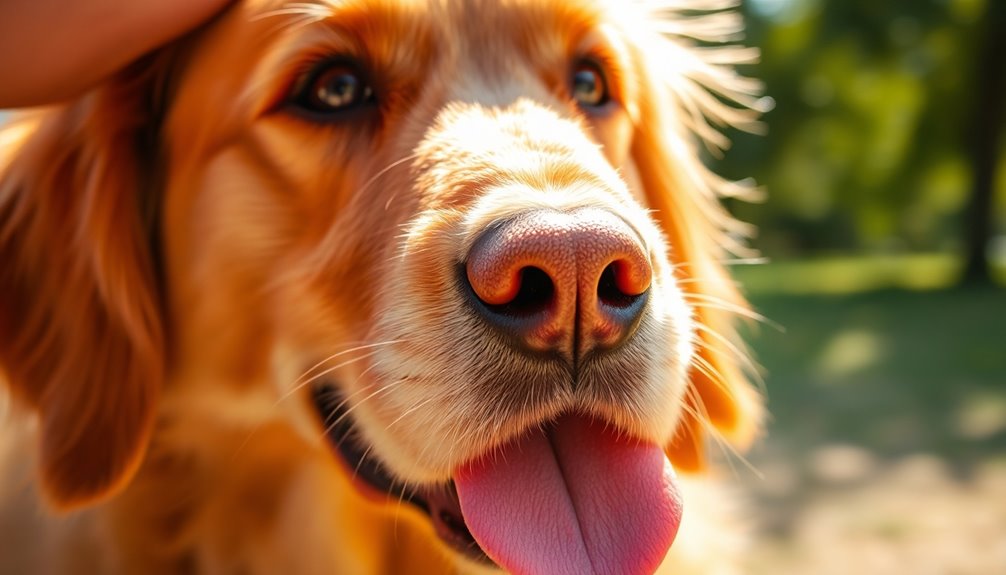
Affectionate gestures often extend beyond eye contact, with licking and nuzzling being two of the most common ways dogs express their love.
When your dog licks your face, hands, or feet, it's their way of showing loyalty and affection. This behavior harks back to their puppyhood, where licking their mother provided comfort and care. Licking releases feel-good hormones like dopamine and endorphins, making both you and your dog feel happier and more bonded. Furthermore, dogs have a unique ability to taste water, which can enhance their licking behavior. Additionally, licking can serve as a way for dogs to express their emotional needs, fostering a deeper connection with their owners.
They might also lick you when you're upset, offering comfort and empathy. Additionally, if they're seeking attention or initiating playtime, licking can be a cute way to draw you in.
Always pay attention to their body language, as excessive licking might signal discomfort or anxiety.
Gift-Giving and Sharing
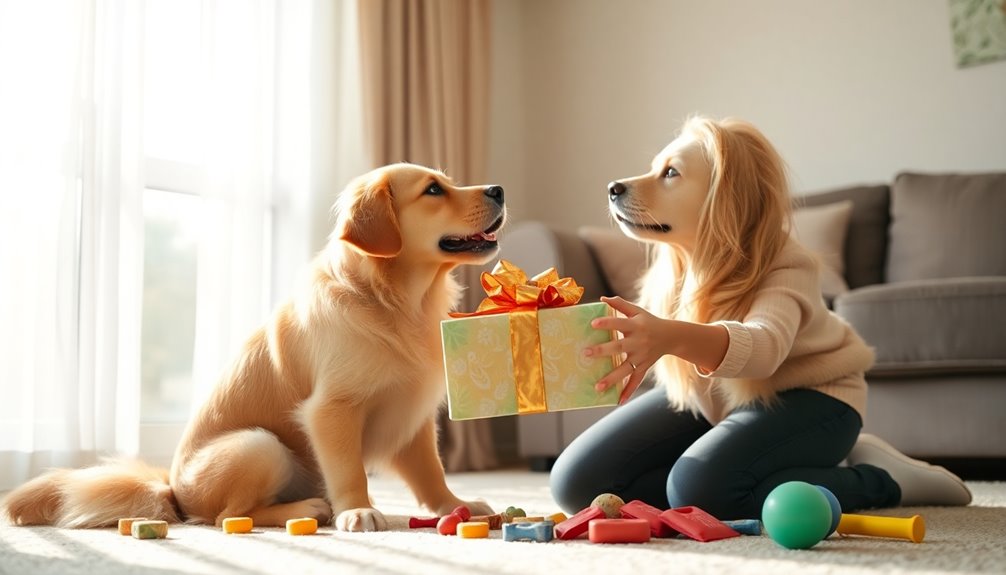
When your furry friend brings you a toy or even a random object from around the house, it's more than just a playful gesture; it's a heartfelt expression of love and trust.
This gift-giving behavior stems from their natural instincts, mirroring ancestral wolves sharing food with their pack. Your dog sees you as family, reflecting respect and a desire to bond. This behavior may also be influenced by a combination of genetic and learned behaviors, which contributes to their instinct to present gifts to their owners. Environmental interactions play a significant role in shaping these affectionate behaviors, as dogs learn from their surroundings and experiences.
Training and positive reinforcement play a significant role; by praising them, you encourage this affectionate habit. Genetic factors also contribute, particularly in breeds like retrievers known for their fetching abilities.
Ultimately, when your dog presents you with a "gift," it's their way of saying they cherish you and want to engage with you in a loving, playful manner.
Behavioral Signs

Dogs express their love and trust through various behaviors that go beyond gift-giving.
When your dog leans against you or curls up next to you, it's a clear sign of affection. They might rest their head on your lap or nuzzle you for closeness and reassurance. Dogs often view their owners as their source of calmness and safety, leading to this behavior.
Prolonged eye contact indicates a deep emotional bond, showing they're connected to you. Their excited greetings when you come home—like tail wagging and jumping—confirm their happiness to see you.
Dogs also exhibit protective behaviors, guarding you while you eat or sleep nearby to feel safe.
When they expose their belly, they're showing trust and inviting you to share in their affection.
These behavioral signs speak volumes about your dog's love.
Following You Around
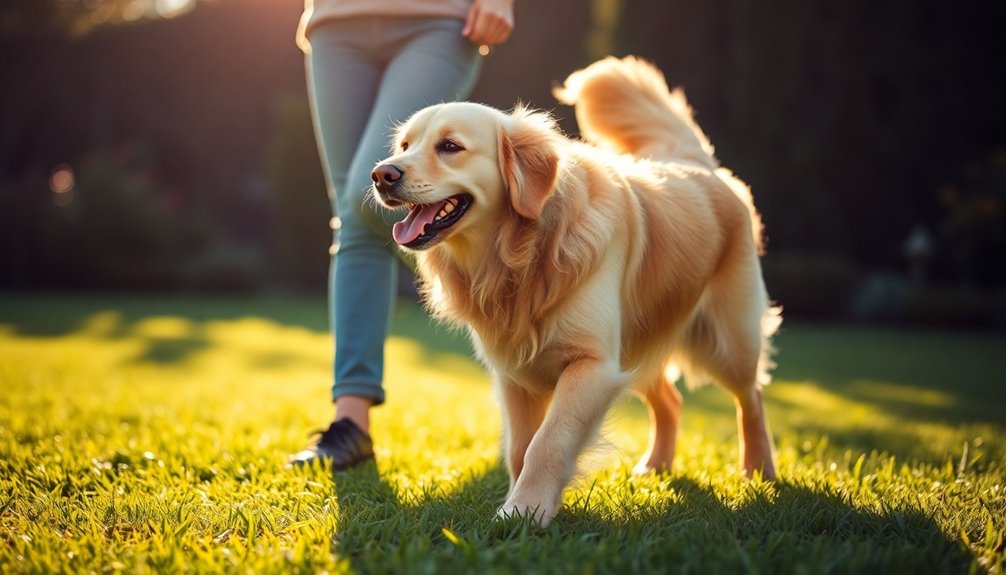
While you go about your day, you might notice your dog closely following your every move. This behavior stems from their genetic instincts as pack animals; they see you as part of their family. By sticking close, they're trying to maintain and strengthen that bond. Additionally, understanding dog behavior includes recognizing that attachment and companionship are key motivators for following.
If your dog seems bored or lacks entertainment, following you around is also a way to seek interaction and mental stimulation. Additionally, this habit shows they trust you and feel secure in your presence.
For puppies, it's a learning experience, while older dogs may follow due to declining senses. Regardless of the reason, when your dog follows you, it's a clear sign of their affection and a desire to be a part of your life.
Sleeping Close to You

As your dog curls up next to you, they're not just seeking warmth; they're expressing a deep-rooted instinct to stay close to their pack. This behavior harks back to their days of sleeping in a pile with their mother and littermates.
By snuggling up, they see you as an essential member of their pack, providing them with security and comfort. This closeness also allows them to feel protected from potential dangers, reinforcing their trust in you. Close proximity fosters a sense of belonging and safety, making them feel even more at ease.
Your dog learns that sleeping near you brings positive reinforcement, like attention and affection. However, if their need to be close feels excessive, it might signal separation anxiety.
Understanding these dynamics strengthens your bond and helps guarantee your dog feels secure in your presence.
Expressive Facial Expressions
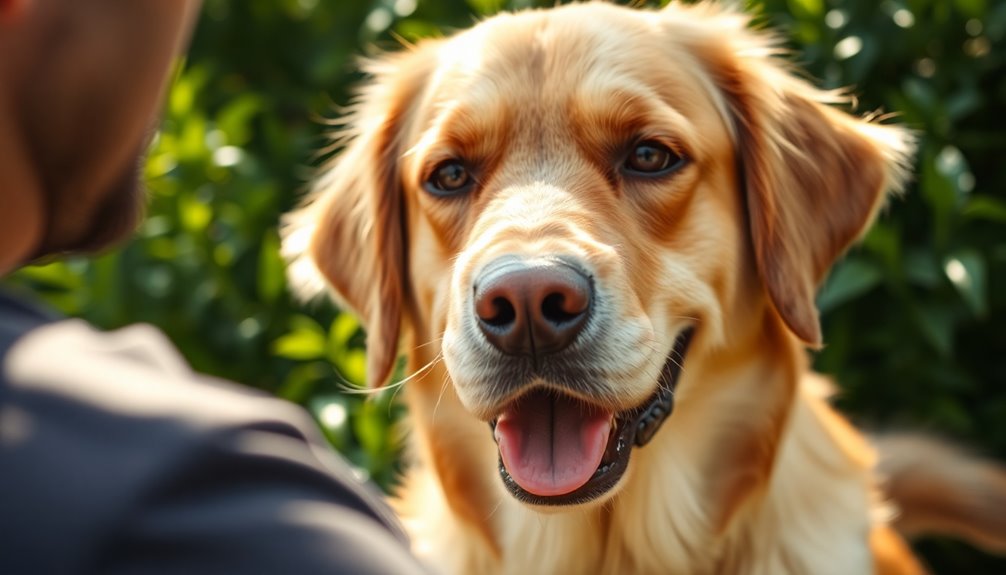
A dog's face is a window into their feelings, showcasing a range of emotions that reflect their affection for you. When your pup gazes into your eyes, it's more than just attention; it's a sign of trust and love, releasing oxytocin that strengthens your bond.
Relaxed eyes and a calm mouth often indicate happiness, while "whale eyes" can signal anxiety. Pay attention to their ears, too—relaxed positions suggest comfort, while alert ears may show excitement. Overly affectionate body language can also be seen in their facial expressions, further emphasizing their emotional connection with you.
A relaxed tongue hanging out usually means contentment, whereas a tightly clenched jaw can indicate stress. Each expression tells a story, revealing how much your furry friend loves and trusts you.
Understanding these signals helps deepen your connection.
Playful Behavior and Engagement
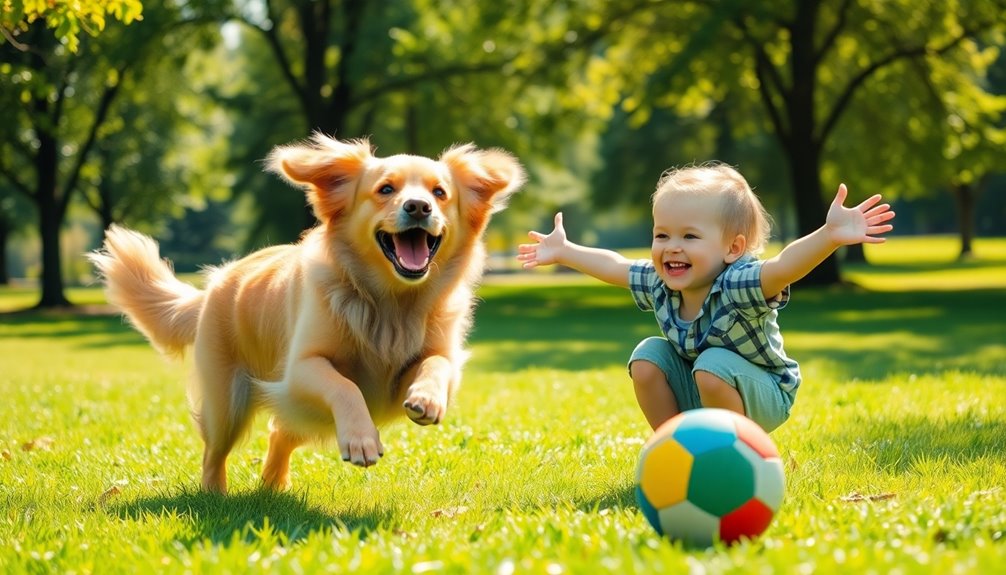
When your dog brings you their favorite toy, it's not just a playful gesture; it's a clear invitation for engagement that reflects their affection and desire for interaction.
Your pup often drops items at your feet, enthusiastic to initiate a game of fetch, and prances around to show they're ready for fun. They seek you out specifically for playtime, choosing your company over other activities.
During play, they might nuzzle or bump against you, demonstrating their need for physical contact. You'll notice their excitement through wagging tails, zoomies, and playful barks. Enthusiastic tail wagging can indicate their joy in your presence, enhancing the playful atmosphere.
Engaging with interactive toys and presenting broken ones showcases their trust and eagerness to share, further deepening the bond between you and your furry friend.
Frequently Asked Questions
Can My Dog Sense My Emotions When I'm Upset?
Yes, your dog can sense when you're upset. They pick up on your emotions through your tone of voice, facial expressions, and body language.
When you're feeling down, your dog might come closer, wag their tail less, or even nuzzle you for comfort.
Their keen senses allow them to recognize the changes in your mood, and they often respond with affection, wanting to support you during tough times.
How Can I Tell if My Dog Is Stressed?
To tell if your dog is stressed, watch for signs like excessive panting, pacing, or shaking.
Their body language can reveal a lot—look for flattened ears, a tucked tail, or stiff muscles.
You might notice changes in their appetite or behavior, such as whining or ignoring your commands.
If they're obsessively licking or seem distracted, it's a good indication they're feeling anxious.
Keeping an eye on these signals can help you understand their feelings.
Do Dogs Remember Past Experiences With Affection?
Yes, dogs do remember past experiences with affection.
They recall moments tied to strong emotions, like playing or cuddling with you. When they encounter familiar stimuli, like your scent or a favorite toy, they often display excitement or joy, indicating those memories are cherished.
Their ability to remember both positive and negative experiences shapes their behavior, making it clear that they hold onto affectionate moments from their past with you.
What Are the Signs My Dog Feels Safe With Me?
If your dog feels safe with you, you'll notice several signs.
They'll lean against you, nudge your hand, or curl up close when resting. You might see a relaxed posture, a wagging tail, and soft eyes.
When your dog maintains eye contact, it shows trust. If they follow you around or expose their belly, that's a big sign of comfort.
These behaviors indicate your dog truly feels secure in your presence.
Can Dogs Feel Jealousy Towards Other Pets or People?
Yes, dogs definitely can feel jealousy towards other pets or people.
You might notice your dog acting possessively, like pushing other pets away or guarding your attention. They could show signs of aggression, clinginess, or even engage in destructive behavior to reclaim your focus.
Changes in routine or introducing new family members can trigger this jealousy.
Being aware of these signs helps you understand your dog's emotions and strengthen your bond with them.
Conclusion
To sum up, your dog definitely knows you love them! Their tail wagging, playful antics, and snuggles are all clear signs of affection. By observing their body language and behaviors, you can strengthen your bond even further. So, keep showering them with love and attention, and enjoy the special connection you share. Remember, your furry friend thrives on your affection, and they'll always show you just how much they care in return.
